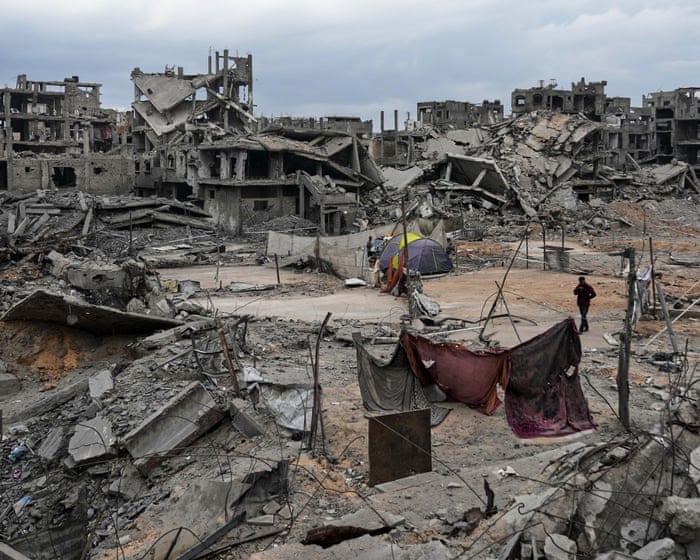Let’s all take a moment to thank Donald Trump, Benjamin Netanyahu, and Jared Kushner—the three wise men who have supposedly brought peace to the Middle East. Blessed are the peacemakers, indeed.
And of course, a special thanks to the Israeli military, which I, as a U.S. taxpayer, have helped fund. As Kushner put it, Israel “chose to be exceptional” rather than imitate the enemy’s “barbarism.”
It must have taken remarkable restraint not to flatten every building and ruin all the farmland in Gaza. Instead, only around 90% of homes are damaged or destroyed. The school system has been wiped out too—over 95% of school buildings need rebuilding or repair, according to satellite assessments. The United Nations Environment Program reports that 97% of tree crops, 95% of shrubs, and 82% of annual crops are gone.
And what exceptional humanity it took not to kill every child in Gaza. Instead, a mere 20,000 children are dead—likely an undercount—with countless more buried under 50 million tons of toxic rubble. Gaza is now home to the largest number of child amputees in the world.
So, once again: thank you, thank you, thank you.
Am I doing this right? Am I showing enough gratitude? Because, judging by the coverage of this so-called “peace deal,” this is the kind of appreciation Palestinians are expected to express. We’re supposed to be thankful that Gaza wasn’t completely nuked or fully occupied. We’re expected to overlook the rising settler violence in the West Bank as if it has nothing to do with Gaza. We’re to ignore that Israel still detains Palestinians like Layan Nasir without charge or evidence. We’re meant to celebrate the end of the “war” and believe this is what peace looks like.
Don’t misunderstand—I’m relieved the bombing has stopped and a ceasefire is in place. I’m overjoyed that more aid is entering Gaza, even as Israel, which has long used food as a weapon, continues to threaten to restrict supplies.
But I won’t celebrate the end of the “war” because this wasn’t a war. In wars, children aren’t systematically shot in the head by snipers. IVF centers and maternity patients aren’t typically targeted. Places aren’t deliberately made uninhabitable. No, this wasn’t a war. As countless human rights experts and international organizations have concluded, it was a genocide.
Genocides don’t happen overnight; dehumanization is often a key first step. Conversely, humanization is essential for lasting peace, justice, and accountability. There can be no real peace until Palestinians are no longer dehumanized—until Israelis and their allies see us as equal human beings, not “barbarians” or “human animals.” Until politicians like Knesset deputy speaker Nissim Vaturi no longer feel comfortable claiming that every child born in Gaza is “already a terrorist from birth.”
In recent years, more people have educated themselves about the century-long war on Palestine. Support for Israel is at record lows in the U.S. as awareness grows about apartheid, settler violence, and occupation. Palestinians are being humanized in the eyes of many who can’t accept that burning displaced civilians alive in so-called “safe zones” or executing healthcare workers is just part of a normal war.Despite the attention from world leaders, policymakers, and the media, the dehumanization of Palestinians appears to be intensifying. A recent episode of HBO’s “Real Time With Bill Maher” serves as an example, where CNN commentator and former Obama adviser Van Jones made a joke about “dead Gaza babies.” Although he has since apologized for being “insensitive,” it’s hard to imagine a major media figure making a similar joke about dead Israeli hostages. The reason is clear: Israelis are generally viewed as human beings, while Palestinians are not. It’s also notable that Jones’s fellow panelist, Thomas Friedman of the New York Times, did not challenge the joke. This isn’t surprising, given that Friedman once wrote a column likening the Middle East to the animal kingdom and Arabs to insects.
Ironically, Van Jones made his comment while accusing Iran and Qatar of running a disinformation campaign to sway young Americans’ opinions on Gaza. Meanwhile, hundreds of millions of dollars are being spent on propaganda aimed at discouraging young Americans from caring about Palestinians. U.S. marketing firms are using bot-based programs to promote pro-Israel narratives on platforms like Instagram, TikTok, LinkedIn, and YouTube. Google has a $45 million contract with Netanyahu’s office to spread Israeli government talking points. Additionally, Drop Site News reported that Jones and journalists from outlets such as the New York Times are now mentors in a fellowship established for a pro-Israel “information war.” This isn’t a path to peace; it’s an effort to rehabilitate the image of a country accused of genocide.
Life in Gaza may have shifted from utter hell to a mere nightmare, but what comes next? The genocide hasn’t ended. While there is a ceasefire, it mirrors the one in Lebanon, where Israel continues to fire. On Tuesday, at least five Palestinians were killed in an Israeli attack in Gaza City. Israel claimed its soldiers targeted “suspects” who crossed the “yellow line,” the boundary set in the ceasefire agreement. Israel has a history of shooting people who cross invisible lines; IDF soldiers have admitted being ordered to shoot anyone entering designated no-go zones, regardless of whether they posed a threat. One soldier told Sky News in July, “There’s an imaginary line that they tell us all the Gazan people know, and that they know they are not allowed to pass it. But how can they know?”
I am grateful that the killing has decreased, but we must not be naive. Gaza has been made uninhabitable for a reason, and settler attacks and home demolitions in the West Bank have increased for a reason. When Israeli leaders speak of “peace” in the region, they seem to mean a peace where Palestinians can be ignored or expelled from their homeland. For instance, in May, Haaretz reported that Netanyahu told the Knesset foreign affairs and security committee, “We are destroying more and more homes. They have nowhere to return to. The only expected outcome will be the desire of Gazans to emigrate out of the Strip.” Netanyahu has often referred to mass population transfer from Gaza, echoing the so-called “Trump plan.” This is the kind of “peace” that Israel and the U.S. appear to be pursuing.
Arwa Mahdawi is a Guardian columnist and the author of “Strong Female Lead.”
Frequently Asked Questions
Of course Here is a list of FAQs about the article Is the war on Gaza really over as were being told Arwa Mahdawi designed to be clear concise and in a natural tone
General BeginnerLevel Questions
1 What is the main point of Arwa Mahdawis article
The main point is that while there may be official announcements of a ceasefire or a pause in active bombing the underlying war is not truly over for the people of Gaza The article argues that the structural violence blockade and humanitarian crisis continue making the conflict far from resolved
2 What does she mean by a war not being over
She means that even without active missile strikes the war continues through other means This includes the ongoing siege that limits food water and medicine the massive destruction of homes and infrastructure and the longterm trauma and displacement of millions of people
3 Who is Arwa Mahdawi
Arwa Mahdawi is a columnist and writer who often comments on politics culture and social justice issues for publications like The Guardian She is known for her sharp critical perspective
4 Why should I be skeptical when I hear the war is over
You should be skeptical because the term over is often used politically to describe a temporary halt in fighting or a reduction in media coverage while the root causes of the conflict and the severe suffering on the ground remain unchanged
Deeper Advanced Questions
5 What is the difference between a ceasefire and a war actually ending
A ceasefire is a temporary pause in fighting A war ending involves a lasting political solution justice for victims reconstruction and the removal of the conditions that led to the war in the first place
6 How does the article describe the role of media and language in shaping our perception of the war
The article suggests that media and governments use vague terms like the war is over to create a sense of closure for international audiences which can lead to decreased attention and pressure even though the reality in Gaza remains a dire emergency
7 What are some of the ongoing aspects of the war that the article highlights
The article highlights the ongoing humanitarian crisis the psychological trauma of a




